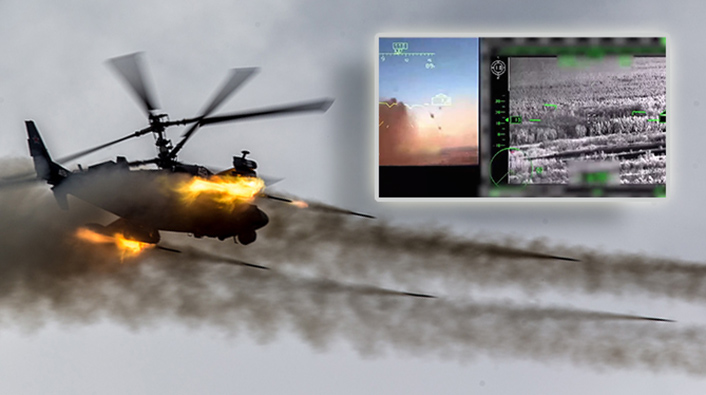A new clip from the cockpit again shows Russian Aerospace Forces attack helicopters turned into airborne MRLS and using unguided rockets, in a quite indiscriminate way.
Few weeks ago we reported about a video coming from Ukraine that showed Russian Ka-52 Hokum-B and Mi-28 Havoc helicopters using what are believed to be unguided 80mm caliber rockets in a pretty unusual way: the clip start with the helicopters flying at low level then pull up into steep climb, and launch the rockets at the top of the parabolic arc of their flightpath, sending them downrange. Then, the footage shows the gunship releasing flares to counter IR-guided MANPADS (Man Portable Air Defense Systems) and breaking hard left and dive down to lower altitude to get out of the air defense systems kill zone.
As we explained, the above tactic, that turns the Russian helicopters into airborne MLRS (Multiple Launch Rocket System) launchers, extends the range of the rockets but is far from accurate, and could only be effectively employed against soft area targets that do not require accuracy or be used to put psychological pressure on the enemy. It vaguely reminds the toss bombing we have seen used to deliver nuclear weapons by tactical aircraft in the Cold War era: the aircraft approached the target at low altitude and high speed, to avoid detection from the enemy radars and interception by enemy fighters. At a distance calculated by the onboard computer (that would take airspeed, altitude, gyroscopic inputs and determine the release point for the desired ballistic path), the aircraft would start a pull-up into a half loop. At 45° (in case of “low toss”) or 90° (in case of “high toss” as in the video) in the steady climb, the weapon, with an upward vector, would be automatically released. Once released, the bomb would follow a ballistic arc towards the target: the toss technique was not too accurate, but precise enough to destroy the intended target with a nuclear weapon…
Even though the Ka-52 fire control system has the functionality to carry out this kind of NLOS (Non-Line of Sight) launch and provide the crew with a roughly accurate launch solution, this type of attack is far from accurate.
On the other side, this attack profile allows the gunships to hit from longer distance while remaining low and possibly outside the range of the lethal Ukrainian air defense systems.
Anyway, although rarely seen before the Ukrainian conflict exposed it, the tactic is part of the Russian helicopter pilots training syllabus and described, for instance, in the Mi-24 handbook.
Back to the Ukrainian conflict, the Russian MOD has just released a new video showing operations of the Ka-52 “Alligator” deployed to Belarus. The clip is particularly interesting as it not only shows the loading of the S-8 rockets in the launchers, but also the attack using the ballistic rocket launch tactic from the cockpit of the helicopter. Interestingly, you can also see the rockets hitting somewhat short and right of the center of the area pointed by the onboard EO/IR camera.
According to the Russians, the Ka-52 destroyed fortified strong points and firing positions of Ukraine Armed Forces armored vehicles. “The crews of the army aviation carried out launches of guided and unguided missiles in pairs from low altitudes, destroying a camouflaged command posts and strong point of the AFU units. The missile attack of army aviation helicopters destroyed armored vehicles and enemy manpower.”
So far, 8x Ka-52 Alligator helicopters have been lost by the Russian Aerospace Forces in Ukraine: some were reportedly shot down by MANPADS, others destroyed by Bayraktar TB2 drones, others damaged and abandoned.










